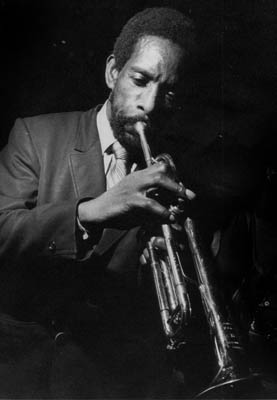Lotus Flower – Kenny Dorham
A meditative, romantic song in that unmistakable Kenny Dorham style. In addition to the lead sheets, Full Score and parts are available for the recorded septet arrangement.
- Recording: Kenny Dorham - Afro-Cuban
- Recorded on: March 29, 1955
- Label: Blue Note (BLP 1535)
- Concert Key: E-flat
- Vocal Range: , to
- Style: Swing (medium slow)
- Trumpet - Kenny Dorham
- Tenor Sax - Hank Mobley
- Trombone - J.J. Johnson
- Baritone Sax - Cecil Payne
- Piano - Horace Silver
- Bass - Percy Heath
- Drums - Art Blakey
- Conga - Carlos "Patato" Valdes
Video
- Description
- Historical Notes
- Solos
- Piano Corner
- Bass Corner
- Drum Corner
- Guitar Corner
- Inside & Beyond
- Minus You
Not to be confused with Lotus Blossom! This meditative song is a great example of K.D.'s signature romantic lyricism, at a slow swing tempo. The form consists of two 12-measure sections, closely related but subtly different and thus marked A1 and A2 in our lead sheet. The melody and changes are largely diatonic but with plenty of those subtle side-slips and passing chords/passing tones that really make Dorham's songs special. Our lead sheet includes a couple of "answer" lines, one in the fifth measure of each section; in the recorded arrangement, the other horns play these lines to respond to the trumpet or trombone melody.
There is an intro which obscures the form: after eight measures of solo piano, the band comes in for three measures of melody flowing directly into the start of the head. The coda starts four measures before the end of the head with a new three-measure phrase leading to 11 measures (mostly with a harmonic "walk down") over an even-8ths Latin groove, with a final tutti staccato line in the last two measures. Note that on the recording, though the horns, piano, bass, and drums play swing 8ths until this part of the coda, conga drummer Patato Valdes is playing even 8ths throughout.
In the intro, only the last three measures of the solo piano section are written out as a cue in the lead sheets. Pianists can improvise the first five measures or read the piano part from the septet arrangement.
About the arrangement: Full Score and parts are available for the recorded arrangement. It's three choruses in total length, with several similar background figures in the in and out heads but no directly repeated sections. The trumpet has the melody through the in head; the other horns go back and forth between harmonizing, "pads" and countermelodies. The second chorus is a trumpet solo, with backgrounds (similar to those on the head) in the second half. The first half of the out head starts with trombone on the melody; the trumpet joins the tenor and baritone saxes for background figures, and returns to the melody from the 11th measure through the second half and coda. Kenny Dorham really plays the melody at the end of his solo chorus; this is shown in our score and trumpet part along with the changes.
There is an intro which obscures the form: after eight measures of solo piano, the band comes in for three measures of melody flowing directly into the start of the head. The coda starts four measures before the end of the head with a new three-measure phrase leading to 11 measures (mostly with a harmonic "walk down") over an even-8ths Latin groove, with a final tutti staccato line in the last two measures. Note that on the recording, though the horns, piano, bass, and drums play swing 8ths until this part of the coda, conga drummer Patato Valdes is playing even 8ths throughout.
In the intro, only the last three measures of the solo piano section are written out as a cue in the lead sheets. Pianists can improvise the first five measures or read the piano part from the septet arrangement.
About the arrangement: Full Score and parts are available for the recorded arrangement. It's three choruses in total length, with several similar background figures in the in and out heads but no directly repeated sections. The trumpet has the melody through the in head; the other horns go back and forth between harmonizing, "pads" and countermelodies. The second chorus is a trumpet solo, with backgrounds (similar to those on the head) in the second half. The first half of the out head starts with trombone on the melody; the trumpet joins the tenor and baritone saxes for background figures, and returns to the melody from the 11th measure through the second half and coda. Kenny Dorham really plays the melody at the end of his solo chorus; this is shown in our score and trumpet part along with the changes.
For more from this second "Afro-Cuban" session (the first was on January 30) check out Kenny's Afrodisia and Gigi Gryce's Basheer's Dream; we also have Echo Of Spring, K.D.'s Motion, La Villa from the first session.
This was the second of only three studio recordings K.D. and J.J. Johnson played on together. Kenny had played on J.J.'s Prestige sextet session on May 26, 1949; in 1957 they were both on Benny Golson's sextet album "The Modern Touch."
"Afro-Cuban" was also the first recording featuring Kenny alongside Cecil Payne. Cecil also played on K.D.'s "Blue Spring" in 1959; Kenny played on two of Cecil's albums, "Patterns Of Jazz" in 1956 and "Zodiac" in 1968.
This was the second of only three studio recordings K.D. and J.J. Johnson played on together. Kenny had played on J.J.'s Prestige sextet session on May 26, 1949; in 1957 they were both on Benny Golson's sextet album "The Modern Touch."
"Afro-Cuban" was also the first recording featuring Kenny alongside Cecil Payne. Cecil also played on K.D.'s "Blue Spring" in 1959; Kenny played on two of Cecil's albums, "Patterns Of Jazz" in 1956 and "Zodiac" in 1968.
Related Songs
Email Send Lotus Flower to a friend
Send this page to a friend via email. Add your name or email in the first field. In the second, add one or more email addresses, separated by a comma.

Kenny Dorham
August 30, 1924 – December 15, 1972
August 30, 2025, is Kenny Dorham's 101st birthday: jazzleadsheets.com has added many new K.D. compositions. Jazz At Lincoln Center has dedicated three late-night sets to Kenny's music, played with love by young musicians who want his music to live on. Join in, play K.D. music! Read more...
There was a problem.
...

